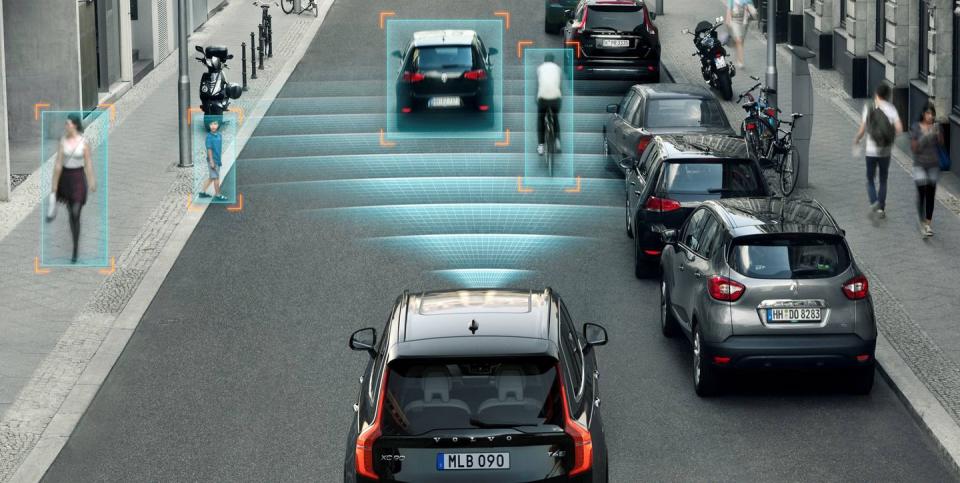NHTSA Says Safety Mandate Would Prevent 360 Deaths, 24,000 Injuries Annually

Automatic emergency braking is set to be mandated, as the National Highway Traffic Safety Administration proposes a federal requirement for all passenger vehicles and light trucks.
Proven to reduce rear-end crashes by 40%, the federal mandate would also focus on pedestrian braking systems, though the rule wouldn't go into effect for at least three years.
Many automakers, including General Motors and Subaru, are standardizing ADAS like automatic braking and lane-keep assist ahead of time.
The National Highway Traffic Safety Administration has been in the news a lot lately. From EV recalls to various Tesla scandals, the federal agency often has its hands full. Beyond divvying out consumer-focused recalls, the NHTSA is responsible for regulating how consumers interact with and drive vehicles—a job it is clearly focused on this year.
Joining the first-ever US proposal of pedestrian protection standards last week, the NHTSA is now proposing the industry standardization of automatic emergency braking on passenger cars and light trucks. The proposed mandates specifically focus on vision-based emergency braking systems that include pedestrian identification. If implemented, NHTSA predicts an estimated 360 lives per year would be saved, along a reduction of 24,000 injuries annually.

"Today, we take an important step forward to save lives and make our roadways safer for all Americans,” US Transportation Secretary Pete Buttigieg said. "Just as lifesaving innovations from previous generations like seatbelts and airbags have helped improve safety, requiring automatic emergency braking on cars and trucks would keep all of us safer on our roads."
The specifics of this proposal are still in the works, though the agency has said it would require all vehicles to demonstrate the automatic ability to stop and avoid collisions from speeds up to 62 mph. Additionally, the rule will be weight limited, as any passenger vehicle or light truck under 10,000 pounds will be included in the mandate. The rule won't go into effect until three years after the publication of a final rule, so leading industry experts to say it won't be implemented for at least four years.
This proposed mandate applies to technology that is present (standard or optional) in nearly all new vehicles already. In 2016, 20 automakers teamed up with the Insurance Institute for Highway Safety and the US Department of Transportation to essentially mandate automatic emergency braking by 2022, in a sort of gentleman's agreement.
The list included Audi, BMW, Ford, General Motors, Mazda, Mercedes-Benz, Tesla, Toyota, Volkswagen, Volvo, Fiat Chrysler (now Stellantis), Honda, Hyundai, Jaguar Land Rover, Kia, Maserati, Mitsubishi, Nissan, Porsche, and Subaru.
This agreement has panned out for the most part, as even base model Toyota Corollas feature automatic emergency braking, but some manufacturers are taking it one step further. For example, General Motors just announced it will standardize on 98% of its 2023 models these technologies: Forward Collision Alert, Front Pedestrian Braking, Lane Keep Assist with Lane Departure Warning, and IntelliBeam auto high-beam control.

This includes GM models such as the $21,495 Chevrolet Trax, though the company didn't specify which models were among the 2% of vehicles not included. Going forward, all GM battery-electric vehicles will receive this suite of ADAS tech as standard, too.
GM is not alone in this push for standardization. Subaru is making its own camera-based collision-avoidance technology (EyeSight) standard on its cheapest models, the Impreza and Crosstrek.
It's difficult to find a manufacturer that hasn't included basic ADAS such as automatic emergency braking and blind-spot detection on even their lowest-end models. However, brands like Mitsubishi and Jeep continue to charge extra for add-on safety systems—a strategy that may soon be challenged by federal mandates.
Ultimately, the federal proposal for mandated automatic emergency braking should affect vehicle pricing. High-end cars generally include these technologies as standard. But a $60,000 2023 Alfa Romeo Stelvio Lusso AWD crossover recently evaluated by Autoweek carried a $1595 optional charge for an Active Assist Plus Package, which included several safety technologies, such as blind-spot assist and lane keeping. And a $57,000 2023 BMW 330e xDrive sedan had a $700 Driving Assistance Package that included adaptive cruise control, blind-spot detection, and lane-departure warning. Across the industry, the technologies are relatively consistent and widely available.
Even if the mandate requires the technology across the board, automakers will figure out a way to pass the costs on to consumers through standard vehicle pricing. The challenge will be for automakers to do so while remaining competitive with their rivals.
Have automated emergency braking systems or forward collision warning ever saved you? Please share your experiences below.

 money
money 